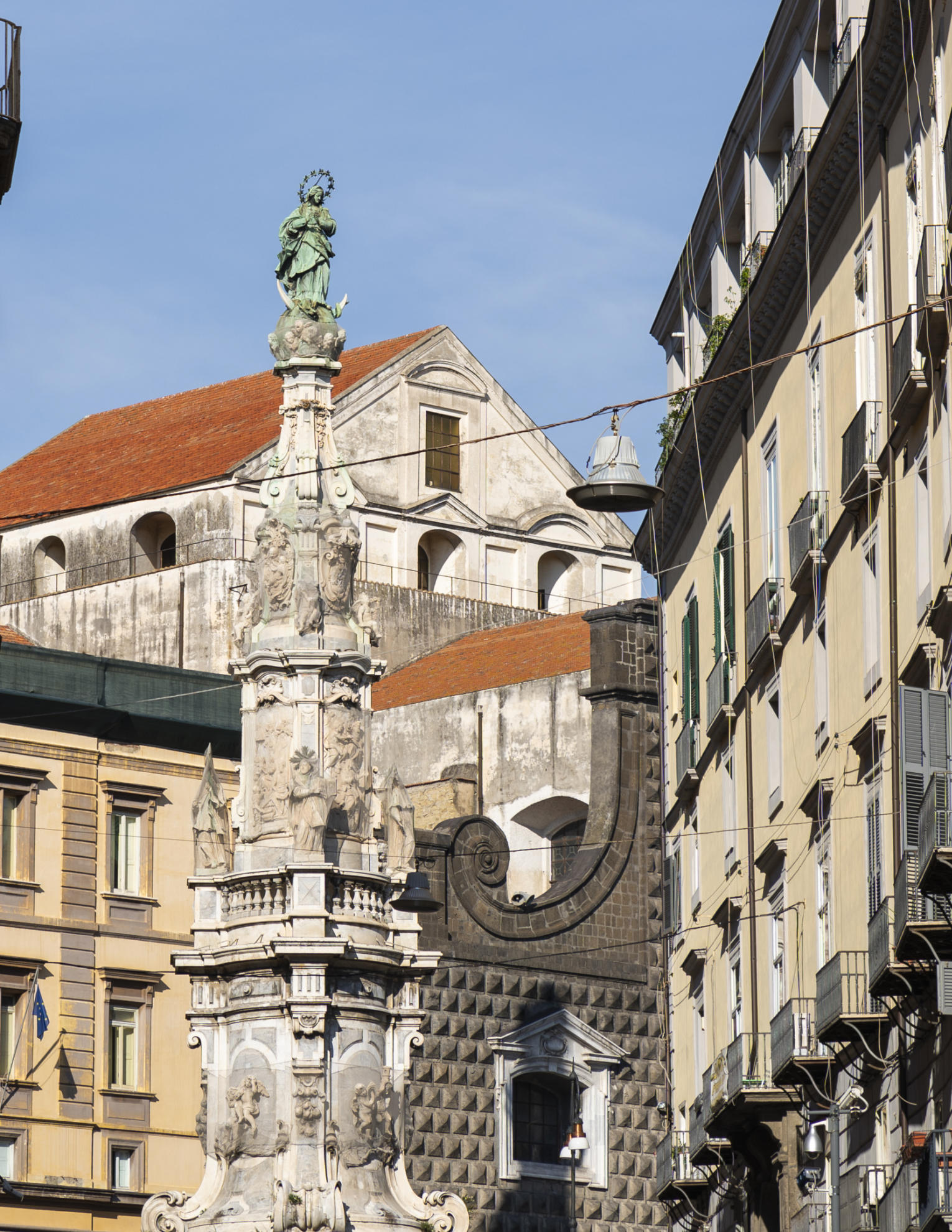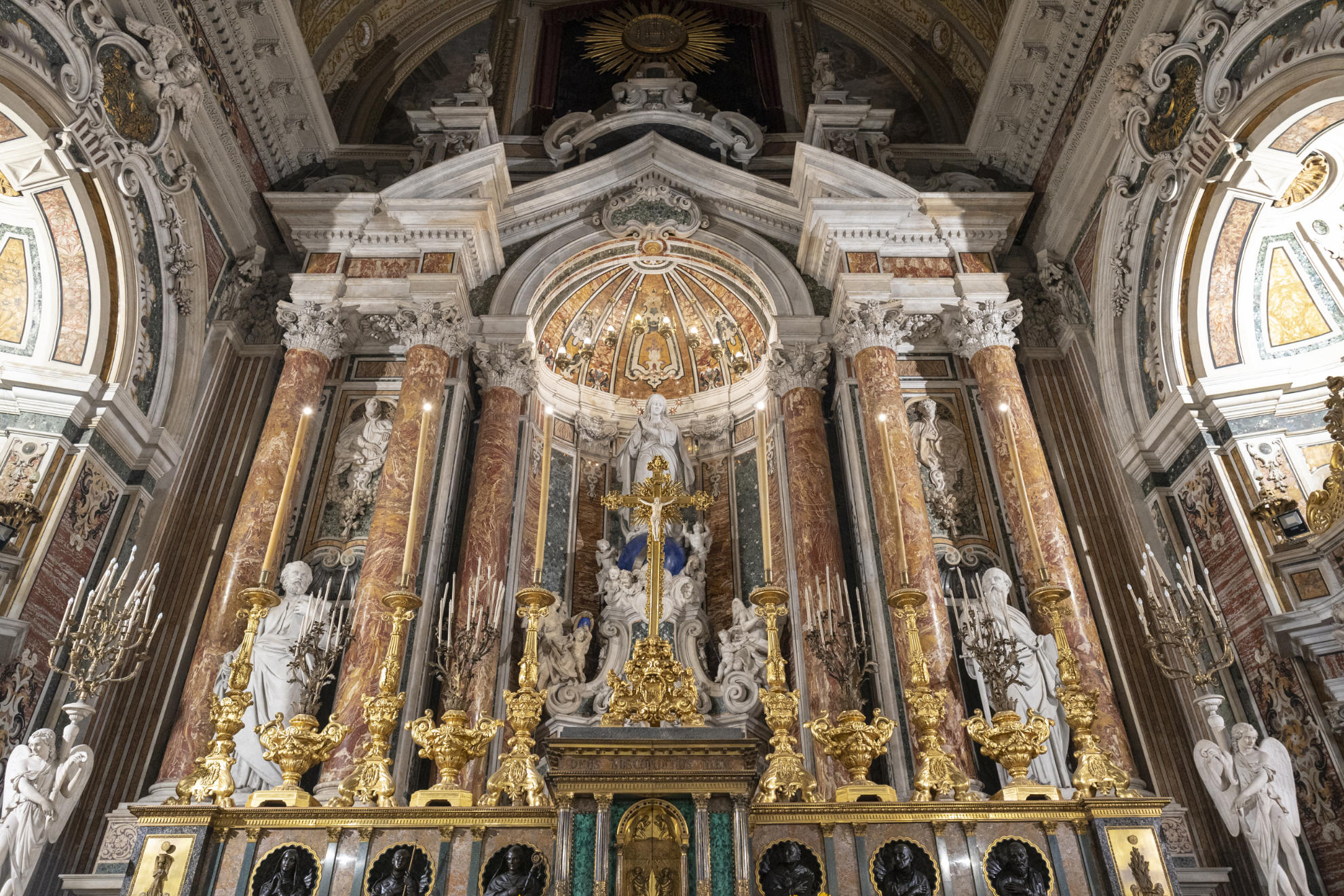Italo Calvino wrote: «Every time you enter a square you find yourself in the middle of a dialogue». It could be added that the protagonists of this exchange are not only the people, but also the buildings.
An exciting dialogue takes place in Naples in Piazza del Gesù, where the historic center, a UNESCO heritage site, begins: a door that reaches the ancient heart of the city.
The perspective from Calata di Trinità Maggiore is perhaps the most evocative one, because a large square, a spire and a scenographic backdrop made up of historic buildings and churches unexpectedly open up in front of your eyes.
The facade of the Gesù Nuovo | Ph. Roberto Salomone

The gaze runs upwards, to the bell tower of the Basilica of Santa Chiara, majestic with its golden facade, then goes back to the center of the square to the sumptuous spire, an obelisk 22 meters high, with the statue of the Immaculate Conception on top. It was built in the 18th century, and was inspired by the “celebration machines” (machines built for special celebrations, usually made of flowers, fabric and wood).
The Immaculate Conception on top of the obelisk | Ph. Roberto Salomone

The mysterious signs engraved on the ashlars of the facade | Ph. Roberto Salomone

Behind it is a strange pointed facade, it would seem the one of an ancient building, with a somewhat austere appearance, decorated on the outside with gray ashlar and a rich marble portal. On closer inspection, right above the main entrance angels are carrying a coat of arms. So, is it a church or a palace? The right answer is: both. Or rather: today it is the celebrated church of Gesù Nuovo, but once upon a time there stood the palace of the Sanseverino, a noble family of the princes of Salerno.
Novellus de Sancto Lucano architector egregius obsequio magisquam salario principi salernitano suo et domino et benefactori precipuo has edes edidit anno MCCCCLXX
Novello from San Lucano, an excellent architect, he built this palace for the Prince of Salerno, his lord and main benefactor, in the year 1470, more out of respect than rewardThe plaque placed on the facade of the church by Novello da San Lucano
At the end of the 16th century the palace with its gardens was taken over by the Society of Jesus, which already had its own foundation in the historic center (hence the name "new"), and was transformed into a church, while maintaining the characteristic facade, imposing and mysterious. Its piperno stones, in fact, hide a secret: they are engraved with strange letters, interpreted differently over the centuries. Esoteric signs, musical notes of a score or, according to the most accredited version, the signature of the stonemasons who worked on the facade in the 1400s.
The central nave of the Gesù Nuovo | Ph. Roberto Salomone

The severity of the exterior contrasts with the kaleidoscope of marble, stucco and golden decorations of the interior, so much so that the eye does not know where to stop. There are chapels dedicated to the main Jesuit saints, precious reliquary busts and then a superb high altar on which, above a globe in lapis lazuli, a statue of the Immaculate Conception made in the 1800s stands. Just like on the top of the spire, there is also a tribute to the Immaculate Conception in the church: it is certainly no coincidence, since both were commissioned by the Jesuits, particularly fond of this cult.
The Immaculate Conception also stands out on the high altar | Ph. Roberto Salomone

The history of the church is closely linked to the very troubled events of the members of the order of Sant'Ignazio di Loyola in Naples: expelled several times from the Kingdom of Naples, they were replaced for a short time by the Franciscans, who dedicated the church to the Trinità Maggiore, as recalled by the name of the road that goes up here. A voice from the past that still dialogues with today's square.

